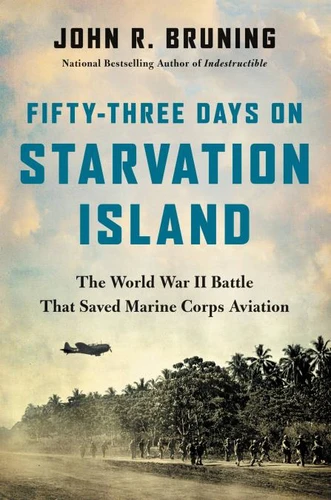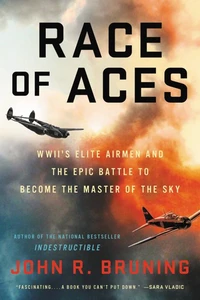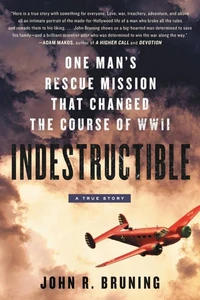Fifty-Three Days on Starvation Island. The World War II Battle That Saved Marine Corps Aviation
Par :Formats :
Disponible dans votre compte client Decitre ou Furet du Nord dès validation de votre commande. Le format ePub protégé est :
- Compatible avec une lecture sur My Vivlio (smartphone, tablette, ordinateur)
- Compatible avec une lecture sur liseuses Vivlio
- Pour les liseuses autres que Vivlio, vous devez utiliser le logiciel Adobe Digital Edition. Non compatible avec la lecture sur les liseuses Kindle, Remarkable et Sony
- Non compatible avec un achat hors France métropolitaine
 , qui est-ce ?
, qui est-ce ?Notre partenaire de plateforme de lecture numérique où vous retrouverez l'ensemble de vos ebooks gratuitement
Pour en savoir plus sur nos ebooks, consultez notre aide en ligne ici
- Nombre de pages320
- FormatePub
- ISBN978-0-316-50868-1
- EAN9780316508681
- Date de parution11/10/2021
- Protection num.Adobe DRM
- Infos supplémentairesepub
- ÉditeurGrand Central Publishing
Résumé
The pivotal true story of the first fifty-three days of the standoff between Imperial Japanese and a handful of Marine aviators defending the Americans dug in at Guadalcanal, from the New York Times bestselling author of Indestructible and Race of Aces. On August 20, 1942, twelve Marine dive-bombers and nineteen Marine fighters landed at Guadalcanal. Their mission: defeat the Japanese navy and prevent it from sending more men and supplies to "Starvation Island, " as Guadalcanal was nicknamed.
The Japanese were turning the remote, jungle-covered mountain in the south Solomon Islands into an air base from which they could attack the supply lines between the U. S. and Australia. The night after the Marines landed and captured the partially completed airfield, the Imperial Navy launched a surprise night attack on the Allied fleet offshore, resulting in the worst defeat the U. S. Navy suffered in the 20th century, which prompted the abandonment of the Marines on Guadalcanal.
The Marines dug in, and waited for help, as those thirty-one pilots and twelve gunners flew against the Japanese, shooting down eighty-three planes in less than two months, while the dive bombers, carried out over thirty attacks on the Japanese fleet. Fifty-Three Days on Starvation Island follows Major John L. Smith, a magnetic leader who became America's top fighter ace for the time; Captain Marion Carl, the Marine Corps' first ace, and one of the few survivors of his squadron at the Battle of Midway.
He would be shot down and forced to make his way back to base through twenty-five miles of Japanese-held jungle. And Major Richard Mangrum, the lawyer-turned-dive-bomber commander whose inexperienced men wrought havoc on the Japanese Navy. New York Times bestselling author John R. Bruning depicts the desperate effort to stop the Japanese long enough for America to muster reinforcements and turn the tide at Guadalcanal.
Not just the story of an incredible stand on a distant jungle island, Fifty-Three Days on Starvation Island also explores the consequences of victory to the men who secured it at a time when America had been at war for less than a year and its public had yet to fully understand what that meant. The home front they returned to after their jungle ordeal was a surreal montage of football games, nightclubs, fine dining with America's elites, and inside looks at dysfunctional defense industries more interested in fleecing the government than properly equipping the military. Bruning tells the story of how one battle reshaped the Marine Corps and propelled its veterans into the highest positions of power just in time to lead the service into a new war in Southeast Asia.
The Japanese were turning the remote, jungle-covered mountain in the south Solomon Islands into an air base from which they could attack the supply lines between the U. S. and Australia. The night after the Marines landed and captured the partially completed airfield, the Imperial Navy launched a surprise night attack on the Allied fleet offshore, resulting in the worst defeat the U. S. Navy suffered in the 20th century, which prompted the abandonment of the Marines on Guadalcanal.
The Marines dug in, and waited for help, as those thirty-one pilots and twelve gunners flew against the Japanese, shooting down eighty-three planes in less than two months, while the dive bombers, carried out over thirty attacks on the Japanese fleet. Fifty-Three Days on Starvation Island follows Major John L. Smith, a magnetic leader who became America's top fighter ace for the time; Captain Marion Carl, the Marine Corps' first ace, and one of the few survivors of his squadron at the Battle of Midway.
He would be shot down and forced to make his way back to base through twenty-five miles of Japanese-held jungle. And Major Richard Mangrum, the lawyer-turned-dive-bomber commander whose inexperienced men wrought havoc on the Japanese Navy. New York Times bestselling author John R. Bruning depicts the desperate effort to stop the Japanese long enough for America to muster reinforcements and turn the tide at Guadalcanal.
Not just the story of an incredible stand on a distant jungle island, Fifty-Three Days on Starvation Island also explores the consequences of victory to the men who secured it at a time when America had been at war for less than a year and its public had yet to fully understand what that meant. The home front they returned to after their jungle ordeal was a surreal montage of football games, nightclubs, fine dining with America's elites, and inside looks at dysfunctional defense industries more interested in fleecing the government than properly equipping the military. Bruning tells the story of how one battle reshaped the Marine Corps and propelled its veterans into the highest positions of power just in time to lead the service into a new war in Southeast Asia.
The pivotal true story of the first fifty-three days of the standoff between Imperial Japanese and a handful of Marine aviators defending the Americans dug in at Guadalcanal, from the New York Times bestselling author of Indestructible and Race of Aces. On August 20, 1942, twelve Marine dive-bombers and nineteen Marine fighters landed at Guadalcanal. Their mission: defeat the Japanese navy and prevent it from sending more men and supplies to "Starvation Island, " as Guadalcanal was nicknamed.
The Japanese were turning the remote, jungle-covered mountain in the south Solomon Islands into an air base from which they could attack the supply lines between the U. S. and Australia. The night after the Marines landed and captured the partially completed airfield, the Imperial Navy launched a surprise night attack on the Allied fleet offshore, resulting in the worst defeat the U. S. Navy suffered in the 20th century, which prompted the abandonment of the Marines on Guadalcanal.
The Marines dug in, and waited for help, as those thirty-one pilots and twelve gunners flew against the Japanese, shooting down eighty-three planes in less than two months, while the dive bombers, carried out over thirty attacks on the Japanese fleet. Fifty-Three Days on Starvation Island follows Major John L. Smith, a magnetic leader who became America's top fighter ace for the time; Captain Marion Carl, the Marine Corps' first ace, and one of the few survivors of his squadron at the Battle of Midway.
He would be shot down and forced to make his way back to base through twenty-five miles of Japanese-held jungle. And Major Richard Mangrum, the lawyer-turned-dive-bomber commander whose inexperienced men wrought havoc on the Japanese Navy. New York Times bestselling author John R. Bruning depicts the desperate effort to stop the Japanese long enough for America to muster reinforcements and turn the tide at Guadalcanal.
Not just the story of an incredible stand on a distant jungle island, Fifty-Three Days on Starvation Island also explores the consequences of victory to the men who secured it at a time when America had been at war for less than a year and its public had yet to fully understand what that meant. The home front they returned to after their jungle ordeal was a surreal montage of football games, nightclubs, fine dining with America's elites, and inside looks at dysfunctional defense industries more interested in fleecing the government than properly equipping the military. Bruning tells the story of how one battle reshaped the Marine Corps and propelled its veterans into the highest positions of power just in time to lead the service into a new war in Southeast Asia.
The Japanese were turning the remote, jungle-covered mountain in the south Solomon Islands into an air base from which they could attack the supply lines between the U. S. and Australia. The night after the Marines landed and captured the partially completed airfield, the Imperial Navy launched a surprise night attack on the Allied fleet offshore, resulting in the worst defeat the U. S. Navy suffered in the 20th century, which prompted the abandonment of the Marines on Guadalcanal.
The Marines dug in, and waited for help, as those thirty-one pilots and twelve gunners flew against the Japanese, shooting down eighty-three planes in less than two months, while the dive bombers, carried out over thirty attacks on the Japanese fleet. Fifty-Three Days on Starvation Island follows Major John L. Smith, a magnetic leader who became America's top fighter ace for the time; Captain Marion Carl, the Marine Corps' first ace, and one of the few survivors of his squadron at the Battle of Midway.
He would be shot down and forced to make his way back to base through twenty-five miles of Japanese-held jungle. And Major Richard Mangrum, the lawyer-turned-dive-bomber commander whose inexperienced men wrought havoc on the Japanese Navy. New York Times bestselling author John R. Bruning depicts the desperate effort to stop the Japanese long enough for America to muster reinforcements and turn the tide at Guadalcanal.
Not just the story of an incredible stand on a distant jungle island, Fifty-Three Days on Starvation Island also explores the consequences of victory to the men who secured it at a time when America had been at war for less than a year and its public had yet to fully understand what that meant. The home front they returned to after their jungle ordeal was a surreal montage of football games, nightclubs, fine dining with America's elites, and inside looks at dysfunctional defense industries more interested in fleecing the government than properly equipping the military. Bruning tells the story of how one battle reshaped the Marine Corps and propelled its veterans into the highest positions of power just in time to lead the service into a new war in Southeast Asia.





